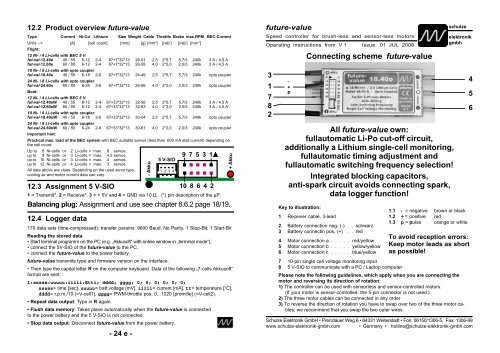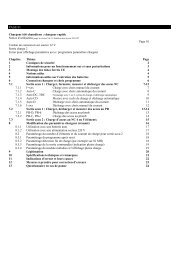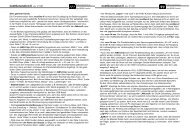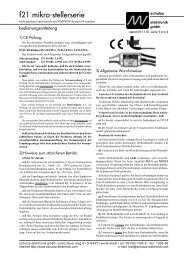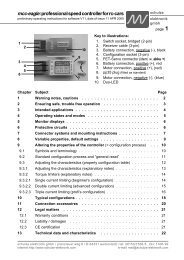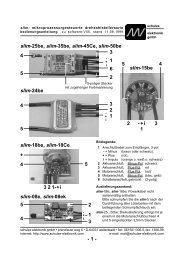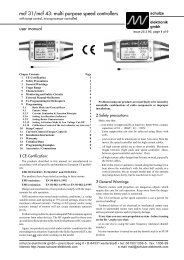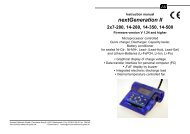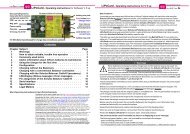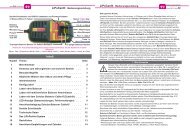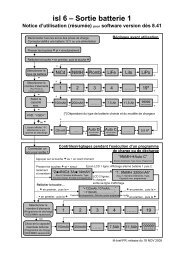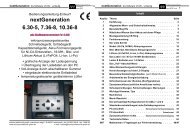TXon RXon - Schulze Elektronik GmbH
TXon RXon - Schulze Elektronik GmbH
TXon RXon - Schulze Elektronik GmbH
Create successful ePaper yourself
Turn your PDF publications into a flip-book with our unique Google optimized e-Paper software.
12.2 Product overview future-value<br />
Type Current Ni-Cd Lithium Size Weight Cable Throttle Brake max.RPM BEC-Current<br />
Units --> [A] [cell count] [mm] [g] [mm2 ] [m�] [m�] [min-1 Flight:<br />
]<br />
12 Ni- / 4 Li-cells with BEC 5 V:<br />
fut-val-12.40e 40 / 55 6-12 2-4 67+7*32*13 26-51 2,5 2*5,7 5,7/3 240k 3 A / 4,5 A<br />
fut-val-12.60e 60 / 80 6-12 2-4 67+7*32*13 26-58 4,0 2*2,0 2,0/3 240k 3 A / 4,5 A<br />
18 Ni- / 6 Li-cells with opto coupler:<br />
fut-val-18.40o 40 / 55 6-18 2-6 67+7*32*13 24-49 2,5 2*5,7 5,7/3 240k opto coupler<br />
24 Ni- / 8 Li-cells with opto coupler:<br />
fut-val-24.60o<br />
Boat:<br />
60 / 80 6-24 2-8 67+7*32*13 24-56 4,0 2*2,0 2,0/3 240k opto coupler<br />
12 Ni- / 4 Li-cells with BEC 5 V:<br />
fut-val-12.40eW 40 / 55 6-12 2-4 67+33*32*13 32-56 2,5 2*5,7 5,7/3 240k 3 A / 4,5 A<br />
fut-val-12.60eW 60 / 80 6-12 2-4 67+33*32*13 32-63 4,0 2*2,0 2,0/3 240k 3 A / 4,5 A<br />
18 Ni- / 6 Li-cells with opto coupler:<br />
fut-val-18.40oW 40 / 55 6-18 2-6 67+33*32*13 30-54 2,5 2*5,7 5,7/3 240k opto coupler<br />
24 Ni- / 8 Li-cells with opto coupler:<br />
fut-val-24.60oW<br />
Important hint:<br />
60 / 80 6-24 2-8 67+33*32*13 30-61 4,0 2*2,0 2,0/3 240k opto coupler<br />
Practical max. load of the BEC system with BEC-suitable servos (less than 600 mA stall current) depending on<br />
the cell count:<br />
Up to 8 Ni-cells or 2 Li-cells = max. 6 servos,<br />
up to 9 Ni-cells or 3 Li-cells = max. 4,5 servos,<br />
up to 10 Ni-cells or 3 Li-cells = max. 4 servos,<br />
up to 12 Ni-cells or 4 Li-cells = max. 3 servos.<br />
All data above are clues. Depending on the used servo type,<br />
cooling air and motor current data can vary.<br />
5 V-SIO<br />
....<br />
1 2 3 4<br />
97531<br />
12.3 Assignment 5 V-SIO<br />
1 = Transmit*, 2 = Receive*, 3 = + 5V and 4 = GND via 10 �� (*) pin description of the µP.<br />
Balancing plug: Assignment and use see chapter 8.6.2 page 18/19.<br />
12.4 Logger data<br />
- 24 e -<br />
- Akku<br />
108642<br />
170 data sets (time-compressed); transfer params: 9600 Baud, No Parity, 1 Stop-Bit, 1 Start-Bit<br />
Reading the stored data<br />
• Start terminal programm on the PC (e.g. „Akkusoft“ with online window in „terminal mode“),<br />
• connect the 5V-SIO of the future-value to the PC,<br />
• connect the future-value to the power battery.<br />
future-value transmits type and firmware version on the interface.<br />
• Then type the capital letter R on the computer keyboard. Data of the following „7-cells Akkusoft“<br />
format are sent:<br />
1:sssss:uuuuu:iiiii:Etti; dddd; gggg; 0; 0; 0; 0; 0; 0;<br />
sssss= time [sec], uuuuu= batt.voltage [mV], iiiii= current [mA], tt= temperature [°C],<br />
dddd= r.p.m./10 (=V-cell1), gggg= PWM-throttle pos. 0...1020 [promille] (=V-cell2).<br />
• Repeat data output: Type in R again.<br />
• Flush data memory: Takes place automatically when the future-value is connected<br />
to the power battery and the 5 V-SIO is not connected.<br />
• Stop data output: Disconnect future-value from the power battery.<br />
+ Akku<br />
future-value<br />
Speed controller for brush-less and sensor-less motors<br />
Operating instructions from V 1 Issue: 01 JUL 2008<br />
3<br />
1<br />
7<br />
8<br />
2<br />
-<br />
+<br />
p<br />
Connecting scheme future-value<br />
All future-value own:<br />
fullautomatic Li-Po cut-off circuit,<br />
additionally a Lithium single-cell monitoring,<br />
fullautomatic timing adjustment and<br />
fullautomatic switching frequency selection!<br />
Integrated blocking capacitors,<br />
anti-spark circuit avoids connecting spark,<br />
data logger function!<br />
schulze<br />
elektronik<br />
gmbh<br />
Key to illustration:<br />
1.1 - = negative brown or black<br />
1 Receiver cable, 3-lead<br />
1.2 + = positive red<br />
2 Battery connection neg. (-) . . schwarz<br />
1.3 p = pulse orange or white<br />
3 Battery connectin pos. (+) . . red<br />
4 Motor connection a . . . . . red/yellow<br />
5 Motor connection b . . . . . yellow/yellow<br />
6 Motor connection c . . . . . blue/yellow<br />
7 10-pin single cell voltage monitoring input<br />
8 5 V-SIO to communicate with a PC / Laptop computer<br />
Please note the following guidelines, which apply when you are connecting the<br />
motor and reversing its direction of rotation:<br />
1) The controller can be used with sensorless and sensor-controlled motors.<br />
(If your motor is sensor-controlled, the 5-pin connector is not used.)<br />
2) The three motor cables can be connected in any order<br />
3) To reverse the direction of rotation you have to swap over two of the three motor cables;<br />
we recommend that you swap the two outer wires.<br />
To avoid reception errors:<br />
Keep motor leads as short<br />
as possible!<br />
<strong>Schulze</strong> <strong>Elektronik</strong> <strong>GmbH</strong> • Prenzlauer Weg 6 • 64331 Weiterstadt • Fon: 06150/1306-5, Fax: 1306-99<br />
www.schulze-elektronik-gmbh.com • Germany • hotline@schulze-elektronik-gmbh.com<br />
4<br />
5<br />
6
Dear customer,<br />
Congratulations on your choice of a future speed controller, which is a micro-computer controlled<br />
unit developed and manufactured entirely in Germany, designed for brushless and sensorless<br />
3-phase rotary current motors.<br />
future controllers have the most intelligent, comprehensive software, which means that this<br />
speed controller is capable of operating virtually any brushless motor currently on the market<br />
with optimum efficiency.<br />
The ips (intelligent programming system)makes it as simple as possible to configure the controller<br />
to match any radio control system and operating mode: The transmitter stick travel settings of<br />
the wing programs is fully automatical, the operating modes for extended soft start or reverse gear<br />
are managed by simple position settings of the transmitter stick. Moreover the future-value can<br />
be configured by the future-soft.<br />
Contents<br />
Chapter Subject Page<br />
1 Warning notes, cautions . . . . . . . . . . . . . . . . . . . . . 3<br />
2 Ensuring safe, trouble free operation . . . . . . . . . . . . . . 4<br />
3 Intended applications and common highlights . . . . . . . . . 5<br />
4 Protective circuits . . . . . . . . . . . . . . . . . . . . . . . . . 6<br />
5 Monitor displays . . . . . . . . . . . . . . . . . . . . . . . . . . 7<br />
6 Installing and connecting the unit . . . . . . . . . . . . . . . . 7<br />
7 Connector systems and mounting instructions, Servos . . . . 8<br />
8 Using the controller for the first time . . . . . . . . . . . . . . 10-17<br />
8.1 ips - the intelligent programming system . . . . . . . . . . . . . . 10<br />
8.2 Symbols and terminology . . . . . . . . . . . . . . . . . . . . . . 11<br />
8.3.1 Mode setting for Wing aircraft models; brake on . . . . . . . . . . 12<br />
8.3.2 Mode setting for Wing aircraft models; geared motor, brake on . . 13<br />
8.3.3 Mode setting for Wing aircraft models; brake off . . . . . . . . . . 14<br />
8.3.4 Mode setting for Wing aircraft models; geared motor, brake off . . 15<br />
8.3.5 Mode setting for Boat models; reverse off . . . . . . . . . . . . . 16<br />
8.3.6 Mode setting for Boat models; reverse on . . . . . . . . . . . . . 17<br />
8.4 Changing the part-load switching frequency. . . . . . . . . . . . 18<br />
8.5 Changing the motor timing . . . . . . . . . . . . . . . . . . . . . 18<br />
8.6 Common about the cut off voltage . . . . . . . . . . . . . . . . . 18<br />
9 Tips . . . . . . . . . . . . . . . . . . . . . . . . . . . . . . . . . 20<br />
10 Accessories . . . . . . . . . . . . . . . . . . . . . . . . . . . . 21<br />
11 Legal matters . . . . . . . . . . . . . . . . . . . . . . . . . . . 22<br />
12 Specifications / Product overview / interfaces . . . . . . . . . 23<br />
12 Specifications<br />
12.1 Key to product summary future-value on the next page<br />
Weight: Excluding - including cables<br />
Current rating: Nominal current / maximum current: The excess current level lies above<br />
the maximum current value for each unit.<br />
The nominal current value is the continuous current at full throttle at which the future can<br />
be operated when connected to a 2 Ah battery without forced cooling. The nominal current<br />
value actually achieved may vary in either direction with different types of motor, rotational<br />
speeds and cell counts.<br />
Throttle, brake: Internal resistance of the MOSFETs, based on data sheet values (25°C).<br />
At 125°C the resistance is about 40% higher. For this reason you should always provide<br />
an effective flow of cooling air over the future to prevent it getting too hot.<br />
Pulse times: Allowed range: 0.8 ms ... 2.5 ms, cycle time: 10 ... 30 ms.<br />
Rotational speed: The rotational speed stated above is the limit value for a 2-pole motor<br />
(...P2). The following division factors apply: P4= /2; P6= /3; P8= /4; P10= /5.<br />
BEC: The stated peak current is dictated by the maximum current value of the 5V<br />
voltage regulator; it can only flow for less than 0.5 seconds, followed by a cooling-off period.<br />
The stated continous current is much lower and is determined by the maximum power<br />
dissipation of the voltage regulator and the heat dissipation of the future-PCB (4.5 W)<br />
(U = U - 5 V BEC voltage).<br />
loss battery<br />
Pay attention when connecting micro-servos: the current consumption is mostly 2...3<br />
times higher than the current of the Graupner C341 servo! The BEC System can be overload<br />
by temperature when using more than 8 Ni-cells (3 Lithium cells) and more than 3<br />
servos!<br />
Part-load-switching frequencies: 7 up to 35,2 kHz - automatically selected/adjusted.<br />
Soft-start: The soft-start feature on throttle and brake is optimized for the requirements<br />
in aircraft or boats. Beyond that the soft start can be adapted (slow down) to leightweight<br />
and fragile gears.<br />
Temperature: Overtemperature threshold is approximately 110°C.<br />
Note: If you have been using a sensor-controlled speed controller, you may find<br />
that now your motor’s maximum speed is different when you use the future. The timing of<br />
sensor-equipped motors is set for a particular rotational speed and a particular load (similar<br />
to the advance setting of an internal combustion engine’s timing), but the future automatically<br />
optimises the timing (within the pre-setted timing) for maximum efficiency under<br />
all load conditions. This means that the timing does not depend on the position of the<br />
speed sensors as dictated by the mechanical design, nor on the accuracy with which they<br />
are installed. The net result is that you may find that the maximum rotational speed of your<br />
motor is higher - combined with higher current; or lower - combined with lower current.<br />
For this reason it may prove necessary to experiment with new propeller sizes when you<br />
make the switch to a sensorless controller or you simply use the timing adjustment features<br />
of this type of future.<br />
- 2 e - - 23 e -
11 Legal matters<br />
11.1 Warranty<br />
All <strong>Schulze</strong> devices are carefully checked and tested before dispatch.<br />
If you have a complaint, send the unit back to us with a clear description of the fault.<br />
A message such as "doesn't work properly" or "software error" doesn't help us much!<br />
For all supply of warranty services our Terms of Sale and Supply are applicable (see<br />
<strong>Schulze</strong> Homepage).<br />
One further note:<br />
If a problem arises with any schulze product, send it directly to us without interfering with<br />
it in any way.<br />
Changes or extensions of the device can lead to additional costs if these impede or<br />
prevent services.<br />
Non-suitable components will be replaced or build back to the delivered condition at the<br />
owners expense without any consultation.<br />
This ensures that we can repair the unit quickly, pick up warranty faults without any<br />
dispute, and keep costs to a minimum.<br />
You can also be sure that we will fit genuine replacement parts which will work properly in<br />
your unit. Unfortunately we have had bad experience with third-party Service Centres<br />
which claim technical competence. Note also that any out-side interference with our<br />
products invalidates the warranty. Incompetent attempts at repair can cause further<br />
damage. We often find it impossible to estimate the repair cost of devices in such<br />
condition, and in certain circumstances we are then obliged to decline to repair it<br />
altogether.<br />
11.2 CE approval<br />
All <strong>Schulze</strong> devices satisfy all relevant and mandatory EC directives:<br />
These are the<br />
EMF directive 89/336/EWG: 3.May 1989 plus<br />
additional changes up to 3. January 1994<br />
The product has been tested to meet the following basic technical standards:<br />
Interference radiation: DIN EN 55014-1: 2003-09<br />
Interference susceptibility: DIN EN 55014-2: 2002-08<br />
You are the owner of a product whose design and construction fulfil the safety aims of the<br />
EC for the safe operation of devices.<br />
The approval procedure includes a test of interference radiation, i.e. of interference<br />
generated by the speed controller. This speed controller has been tested under practical<br />
conditions at maximum load current and with a large number of cells, and remains within<br />
the interference limits.<br />
A less stringent test would be, for example, to measure interference levels at a low<br />
current. In such cases the speed controller would not produce its maximum interference<br />
level.<br />
The procedure also includes also a test of interference susceptibility, i.e. the extent to<br />
which the device is vulnerable to interference from other devices. The test involves<br />
subjecting the speed controller to RF signals similar to those produced by an RC transmitter<br />
or a radio telephone.<br />
- 22 e -<br />
1 Warning notes, cautions<br />
Electric motors fitted with propellers are dangerous<br />
and require proper care for safe operation.<br />
Keep well clear of the propeller at all<br />
times when the battery pack is connected.<br />
Technical defects of an electrical or mechanical<br />
nature may result in unintended motor<br />
runs; loose parts may cause serious personal<br />
injuriy and/or property damage.<br />
The CE-certificate on the speed controller<br />
does not absolve you from taking proper care<br />
when handling the system!<br />
Speed controllers are exclusively for use in<br />
RC models. Their use in man-carrying models<br />
is prohibited.<br />
Speed controllers are not protected against<br />
reverse polarity (+ terminal and - terminal reversed).<br />
Connecting the battery pack to the<br />
motor leads of the controller will almost certainly<br />
cause irreparable damage.<br />
Electronic equipment is sensitive to humidity.<br />
Speed controllers which have got wet may<br />
not function properly even after thorough drying.<br />
You should send them back to us for<br />
cleaning and testing.<br />
Do not use speed controllers in conjunction<br />
with a power supply connected to the mains.<br />
Energy reversal can occur when the motor<br />
slows down and stops, and this may damage<br />
the power supply or cause an over-voltage<br />
condition which could damage the controller.<br />
Never disconnect the flight pack while the<br />
motor is running, as this could cause damage<br />
on a speed controller.<br />
Please take care when switching off the receiver<br />
battery: depending on the receiver you<br />
are using, it may send an incorrect throttle<br />
signal to the future at this moment, which<br />
could then cause the motor to burst into life<br />
unexpectedly.<br />
If you are using a future with BEC system:<br />
a) On no account connect a separate receiver<br />
battery or an electronic battery switch (two<br />
receiver batteries), as this may cause damage<br />
to the speed controller and could cause<br />
current to flow from the receiver battery to<br />
the motor.<br />
- 3 e -<br />
b) If you want to use a separate receiver battery<br />
cut through the + wire in the receiver cable,<br />
or pull it out of the connector if possible.<br />
However, for greater protection against motor-inducted<br />
interference it is always better to<br />
use a speed controller with an opto-coupler.<br />
Protect the speed controller from mechanical<br />
loads, vibration, dirt and contamination.<br />
Keep the cables to the motor as short as<br />
possible (max. length = 10 cm / 4”).<br />
Do not exceed the maximum stated length of<br />
cable between battery and future (max.<br />
length: 20 cm / 7...8"). The wiring inside the<br />
battery pack must also be as short as possible.<br />
Use in-line soldered “stick” packs.<br />
For the same reason, use a clamp-type amperemeter,<br />
not a series meter with shunt resistor.<br />
Never leave the flight battery connected<br />
when ...<br />
... the model is not in use and/or<br />
... the battery pack is being charged.<br />
Although some speed controllers feature a<br />
separate On/Off switch, this does not isolate<br />
it completely from the battery.<br />
Speed controllers can only function properly<br />
if they are in full working condition. The protective<br />
and monitoring circuits can also only<br />
work if the speed controller is in good operating<br />
condition.<br />
In the case of motor failure (e.g.short circuits<br />
in the windings) the over-temperature sensor<br />
in the controllers may react too slowly to prevent<br />
damage. switch the motor off immediately<br />
to prevent permanent damage to the speed<br />
controller.<br />
Note: Please remember that the monitoring<br />
circuits are unable to detect every abnormal<br />
operating condition, such as a short between<br />
the motor cables. Note also that a stalled motor<br />
will only trip the current limiter if the motor's<br />
stall current is well above the controller's<br />
peak current. For example, if you are using<br />
an 80 A controller in conjunction with a 20<br />
A motor, the current monitor will not detect an<br />
excessive current even when the motor is<br />
stalled.
2 Ensuring safe, trouble-free operation<br />
Use only compatible connectors. A 2 mm<br />
pin cannot provide reliable contact in a 2.5<br />
mm socket. The same applies with 2mm<br />
gold-contact pins and 2 mm tin-plated<br />
sockets.<br />
Please also remember that ...<br />
... the wiring of your RC-components must<br />
be checked regularly for loose wires, oxidation,<br />
or damaged insulation, especially<br />
when using a BEC system.<br />
... your receiver and the aerial must be at<br />
least 3 cm (>1") away from motor, speed<br />
controller and high-current cables. For example,<br />
the magnetic fields around the<br />
high-current cables can cause interference<br />
to the receiver.<br />
... all high-current cables must be as short<br />
as possible. Maximum length between<br />
flight pack and speed controller should<br />
never exceed 20 cm (7"), between speed<br />
controller and motor: 10 cm (4").<br />
... all high-current cables longer than 5 cm<br />
(2") must be twisted together. This applies<br />
in particular to the motor power cables,<br />
which are very powerful sources of radiated<br />
interference.<br />
... in model aircraft: half of the receiver<br />
aerial's length should be routed along the<br />
fuselage, the other half should be allowed<br />
to trail freely (take care not to tread on it).<br />
Do not attach the end of the aerial to the<br />
fin!<br />
... in model boats: half of the receiver aerial's<br />
length should be deployed inside the<br />
hull above the waterline, the other half<br />
should be threaded into a small tube<br />
mounted upright.<br />
Every time you intend to use the power<br />
system - before you turn on the receiver<br />
- make sure that ...<br />
... no one else is using the same frequency<br />
(identical channel number).<br />
... your transmitter is switched on and the<br />
throttle stick is (as a rule) in the STOP position<br />
(exceptions see Section 8).<br />
- 4 e -<br />
Carry out a range check before each flight.<br />
Ask an assistand to hold the model aircraft<br />
and set the throttle stick to the half throttle<br />
position. Collapse the transmitter aerial.<br />
Walk away from the model to the distance<br />
stated by the RC system manufacturer<br />
(this might be a distance of about 50-60 m<br />
= 200'). Make sure that you still have full<br />
control of the system at this range.<br />
As a general rule: receiver interference is<br />
more likely to occur when using a controller<br />
with BEC system, as these units do not<br />
feature an opto-coupler with its optical link.<br />
When Ni-Cd batteries approach the end of<br />
their charge, voltage falls drastically and<br />
quickly. The future detects this and reduces<br />
power to the motor automatically. This<br />
should leave sufficient energy to bring your<br />
model safely back home. However, if you<br />
use a small number of cells of high internal<br />
resistance and operate at high motor currents,<br />
the controller may reduce power before<br />
the pack is discharged. You can eliminate<br />
this problem by using low resistance<br />
straps to connect the cells, or use the direct<br />
cell-to-cell soldering technique<br />
(“sticks”) and short, heavy-gauge wire if<br />
you assemble your own batteries.<br />
Your receiver also benefits from the stability<br />
of the voltage supplied from the battery<br />
by a BEC system. If the BEC voltage is<br />
stable, the receiver is less liable to suffer<br />
interference.<br />
The CE symbol is your guarantee that the<br />
unit meets all the relevant interference<br />
emission and rejection regulations when it<br />
is in use.<br />
If you encounter problems operating the<br />
future controller, please note that many<br />
problems are due to an unsuitable combination<br />
of receiving system components, or<br />
an inadequate installation in the model.<br />
10 Accessories<br />
10.1 <strong>Schulze</strong> BalCab10-Verl<br />
Ready-made balancer cable for connecting<br />
<strong>Schulze</strong> LiPoPerfekt battery packs to<br />
the measuring inputs. 10-leads for 2 ... 4<br />
cells in series.<br />
10.2 BalCab20-Verl (without illustration).<br />
As above, but 20-leads (2...8 cells).<br />
10.3 future-soft<br />
Software similar to the „u-soft“ to configure<br />
the future-value via PC/Laptop<br />
(e.g. softstart, under voltage limits, e.t.c).<br />
In preparation.<br />
10.4 USB-adapt-uni<br />
Active adapter to connect the 5 V-SIO of<br />
the future-value with the USB interface<br />
of a PC or Laptop.<br />
10.5 USB-Kabel (without illustration)<br />
Cable to connect the USB-adapt-uni with<br />
the PC or Laptop.<br />
10.6 prog-adapt-uni<br />
Active adapter to connect the 5 V-SIO of<br />
the future-value with the RS232 interface<br />
(COMx) of a PC or Laptop.<br />
Adapter cable for Thunder-/Flight-Power<br />
batteries (pin spacing 2.0 mm)<br />
10.81 FutValAdapt-TP8 2s - 8s<br />
Adapter cable for Kokam / Robbe /<br />
Graupner batt. (pin spacing 2.54 mm)<br />
10.82 FutValAdapt-Ko6 2s - 6s<br />
10.83 FutValAdapt-Ko8 2s - 8s<br />
10.84 FutValAdapt-Ko2x4 2*2s-4s<br />
- 21 e -<br />
10.8x<br />
10.82<br />
Free<br />
download<br />
from the<br />
<strong>Schulze</strong> Homepage<br />
(10.83 similar)<br />
10.81<br />
10.84
9 Tips<br />
9.1 Rotational speeds<br />
future-value speed controllers can drive the motor - in comparison to speed controllers of other<br />
manufacturers - with slightly different rotational speed at the same supply voltage.This effect is<br />
caused by the automatically setted (and varied) timing. The resultant difference of the rotational<br />
speed can be higher or lower.<br />
9.2 Start-up problems, controller faults<br />
We have now established that the usual cause of unreliable motor start-up problems is poor<br />
contact in the connectors.<br />
Inadequate contact can result in faults due to excessive voltage, especially when the highvoltage<br />
versions of the future are used, because the high resistance of the connectors prevents<br />
the voltage being passed back into the battery at mid-range settings, and especially during<br />
braking.<br />
Examples of poor practice<br />
• Solder between the contact segments of the plug<br />
-> Remedy: solder on a brand-new plug.<br />
• Resin (electronic solder flux) under the contact segments of the plug<br />
-> Remedy: remove flux residues with meths or contact cleaner.<br />
• Over-long leads between battery and future<br />
-> Remedy: shorten to permissible length (chapter 6).<br />
• Lack of spring pressure in the contact segments<br />
-> Remedy: solder on brand-new plugs, and be sure to cool the segments when soldering!<br />
• Poor-quality connectors. Oxidised sockets (black inside), discoloured gold plating (greenish or<br />
grey).<br />
-> Remedy: use high-quality plugs and sockets from a brand-name manufacturer<br />
-> Remedy: don’t use cheap goods from the Far East<br />
-> Remedy: contact segments should be made of copper-beryllium - no mild steel contacts!<br />
9.3 Overheating motors<br />
If you are using a Graupner Carbon 70, Hacker, Kontronik BL or Simprop motor, never shorten<br />
the winding wires which project from the motor. The strands are coated with high-temperature<br />
lacquer, and it is impossible to solder through this material. To obtain a sound soldered joint you<br />
must mechanically remove the lacquer coating all round each individual strand. Any strands<br />
which are not soldered or fractured cause an increase in current flow through each remaining<br />
wire, and this in turn causes a lower efficiency and increase in motor temperature.<br />
9.4 Interferences<br />
We regognized some interference in combination with certain types of motors. These interferences<br />
occurs in combinations with different manufacturers of controllers.<br />
9.5 Multi motor operation<br />
In general terms we do not recommend operating multiple motors with a future. From some of<br />
our customers we have heard that this certainly works with some (but not all) Aveox, Hacker,<br />
Kontronik or Lehner motors, provided that the currents do not exceed the permissible maximum<br />
values for the speed controller concerned. However, we cannot guarantee that both motors will<br />
rotate over the full load range.<br />
It is never permissible to run more than one Plettenberg or Köhler motor connected to a single<br />
future: you must use a separate future for each motor. However, you can certainly power both<br />
controllers from a single drive battery.<br />
- 20 e -<br />
3 Intended applications and common highlights<br />
Common highlights<br />
All future of this series can be used for Wing-<br />
Aircraft-Models or Boat-Models. Some types<br />
include an opto-coupler which ensures minimum<br />
possible transfer of interference to your receiver.<br />
All future which includes a „W“ in the Type<br />
declaration are equipped with a boat program<br />
and own a small tube to connect the cooling<br />
water. They are splash water protected (but ist is<br />
not allowed to use them wet). The boat program<br />
includes a reverse gear.<br />
Better than 500-step resolution over the whole<br />
control range for extremely fine speed control.<br />
„Auto-arm“ function and „power on reset“.<br />
„ips“ (intelligent programming system) with no<br />
pots! The future automatically configures itself<br />
every time to the stick travel when you go airborn.<br />
During the “Power-On” process the motor acts as<br />
a loudspeaker to give you audible confirmation of<br />
the procedure.<br />
All future-value own a fully automatic timing and<br />
part load switching frequency adjustment. The<br />
motor characteristics are measured when the<br />
power battery is connected to the future-value.<br />
This helps to run the different motor types near<br />
their optimum.<br />
All future-value are equipped with connectors for<br />
the Lithium single cell voltage monitoring.<br />
The <strong>Schulze</strong> BalCab10 and <strong>Schulze</strong>-BalCab20<br />
connectors and some connectors with a pin<br />
spacing of 2.54 mm (Kokam, Robbe, Graupner)<br />
can be connected without any adapter (See<br />
connecting example in chapter 8.4).<br />
Safety hints:<br />
The future-value with BEC system are „linear“<br />
BEC systems. In comparison to the „switched“<br />
BEC systems - the linear systems have the<br />
advantage, that the receiver in the model can not<br />
be interfered by the switching frequency (because<br />
there is none) of the BEC. The use is more<br />
safe.<br />
The future-value with BEC system are galvanically<br />
coupled by the „-Akku“ (neg. battery) cable<br />
with the receivers GND. The additionally interference<br />
suppressing effect of a transmission by<br />
light (opto coupler) is not existant. Even when<br />
you use a future-value with opto coupler and an<br />
external BEC system is used then the opto coupler<br />
is bridged by the external BEC and for this<br />
reason there is no longer a positive effect.<br />
Umrechnungsfaktor: Eine Lithiumzelle entspricht etwa 3 ... 3,3 Ni-Cd oder Ni-MH Zellen<br />
- 5 e -<br />
Low voltage types with BEC<br />
fut-val-12.40e(W)<br />
For 6-12 Ni-Cd or Ni-MH cells<br />
or 2-4 Lithium cells.<br />
For motors up to 40A*; peak 55 A.<br />
5 V / 3 A BEC System; peak 4.5 A.<br />
fut-val-12.60e(W)<br />
For 6-12 Ni-Cd or Ni-MH cells<br />
or 2-4 Lithium cells.<br />
For motors up to 60A*; peak 80 A.<br />
5 V / 3 A BEC system; peak 4.5 A.<br />
Low voltage types with opto<br />
coupler<br />
fut-val-18.40o(W)<br />
For 6-18 Ni-Cd or Ni-MH cells<br />
or 2-6 Lithium cells.<br />
For motors up to 40A*; peak 55 A.<br />
The receiver pulses are coupled via an opto<br />
coupler to the controller. This means that the<br />
receiver is galvanically separated from the<br />
motor battery. For this reason you are in<br />
need of a receiver battery**.<br />
24 cells high voltage type<br />
with opto coupler<br />
fut-val-24.60o(W)<br />
For 6-24 Ni-Cd or Ni-MH cells<br />
or 2-8 Lithium cells.<br />
For motors up to 60A*; peak 80 A.<br />
The receiver pulses are coupled via an opto<br />
coupler to the controller. This means that the<br />
receiver is galvanically separated from the<br />
motor battery. For this reason you are in<br />
need of a receiver battery**.<br />
(*) The nominal current value is the continuous<br />
current at full throttle at which the<br />
future can be operated when connected to a<br />
2 Ah battery without forced cooling.<br />
(**) We recommend <strong>Schulze</strong> LiPoRxII<br />
receiver current/voltage supplies.<br />
On no account use Ni-MH batteries in the<br />
size AA or AAA. As a rule these batteries<br />
have a higher internal resistance than other<br />
sizes and Ni-MH batteries are not able to<br />
supply high currents at low temperatures.
4 Protective circuits<br />
Note: the monitor circuits are effective, but they<br />
cannot detect every possible operating condition.<br />
Temperature monitor<br />
The temperature monitor throttles down the motor<br />
and later switches off the motor. You can reset<br />
the unit using the "auto-arm" function (throttle<br />
stick to stop for about 2 sec.)<br />
If the motor windings are short-circuited the temperature<br />
monitor reacts too slowly to prevent<br />
damage. switch the motor off immediately to<br />
avoid permanent damage to the speed controller.<br />
Voltage monitor<br />
As soon as the voltage of the drive battery falls<br />
back to the under voltage threshold the motor is<br />
throttled back (more information about the threshold<br />
value see chapter 8.6).<br />
If the situation which caused the controller to<br />
throttle back continues for more than a short<br />
time, the unit switches the motor off.<br />
Of course, you can re-start the motor again<br />
briefly by moving the throttle stick back to "stop"<br />
for about 2 seconds to re-arm the system.<br />
If you use a future without BEC system you retain full<br />
control of the model until the receiver battery is flat;<br />
if you use a future with BEC system the power<br />
system and the model remain fully controllable<br />
until the last usable energy in the flight pack is<br />
exhausted. We can not predict how long you can<br />
still control your model with the residual battery<br />
charge as this depends on many parameters<br />
such as the number of cells in the pack, the cell<br />
type, actual motor current and the way you control<br />
your model. The only solution is for you to<br />
time the period yourself with the model on the<br />
ground. If the voltage monitor trips, i.e. the motor<br />
starts to throttle back without your intervention,<br />
you should stop the motor at once with the throttle<br />
stick in any case so that you have the maximum<br />
possible reserve of power.<br />
Maximum speed monitor<br />
If maximum rotational speed of the motor will<br />
exceed, future throttles down. In this state do not<br />
use longer then 1 second because some motors<br />
could over heat.<br />
Because of this: Do not run motor without airscrew,<br />
possibly the motor switches off after 2<br />
seconds.<br />
Minimum speed monitor<br />
To ensure that the controller detects the rotor<br />
position reliably, this series of future types sets a<br />
defined minimum rotational speed.<br />
This protective function can cause the motor to<br />
be reluctant to start up if its torque limit is exceeded.<br />
If this should happen, check (measure!)<br />
that the maximum permissible motor current is<br />
not exceeded. In this case a propeller one step<br />
smaller in diameter must be used.<br />
Current monitor<br />
The future controllers feature a current monitor<br />
circuit which trips when the current rises above<br />
the specified maximum value. If the motor is<br />
stalled, the motor is throttled back. This means,<br />
that a motor which draws an excessive current<br />
will never reach full-throttle, and the current may<br />
stay below the specified maximum value. If<br />
future is some seconds in current limiting mode,<br />
it will disarm itself (switching off the motor). rearming<br />
= 2 seconds “stopp”.<br />
Receiver signal monitor<br />
If the receiver signal fails, or the signal is longer<br />
or shorter than the usual range of values, the future<br />
controller reverts to hold mode for about 300<br />
milliseconds (helicopter = 1.5 s) before switching<br />
to disarmed mode.<br />
This protection function enables you to eliminate<br />
receiver interference before you actually<br />
lose your model, perhaps by modifying the installation<br />
or changing the radio control components.<br />
Reverse polarity protection<br />
The future is not protected against reverse polarity!<br />
Anti-Spark<br />
The future have feature an additional circuit<br />
which avoids the connecting spark (and for this<br />
reason the damage on the connectors) when the<br />
future is connected to the power battery.<br />
Watchdog<br />
If this circuit is tripped the speed controller stops<br />
working briefly and then reverts to normal operation.<br />
Error codes<br />
Under certain circumstances future controllers<br />
refuses to work after connection to the power<br />
battery and beeps - if possible - an error code:<br />
4 beeps:<br />
battery weak (empty or high impedance) or<br />
battery cables too long. (Remedy e.g. by adding<br />
a low ESR electrolytic capacitor near the future -<br />
see picture in chapter 6).<br />
5 beeps:<br />
motor too strong or short circuit in the windings.<br />
6 beeps:<br />
double tone beep, normal beep, double tone ...<br />
(motor defective, battery weak, future defective)<br />
- 6 e -<br />
Especially we do not measure the „+“ and „-“ battery voltage which<br />
are supplied in any case via the power cables of the future-value.<br />
The assignment of the measuring inputs is as shown below. It is not<br />
necessary that the individual cell voltages must be ascendant to<br />
the numbers in the figure below and it is also not necessary that<br />
they must be completely connected because an additional protection<br />
is existing through the total battery voltage.<br />
The single cell voltages are mesured<br />
97531 according to the assignment of a<br />
5 V-SIO<br />
....<br />
<strong>Schulze</strong> BalCab20 socket on the<br />
1 2 3 4<br />
pins 2...8. The „+“ (positive) terminal<br />
of the cells can be connected in any<br />
108642 order to the pins 2-8.<br />
- Akku<br />
BalCab 20<br />
pin 1 mark<br />
+ Akku<br />
BalCab 10<br />
Kokam<br />
5s<br />
GND - do not connect<br />
Kokam<br />
2s<br />
8.6.3 When the Lithium single voltage monitoring detects an undervoltage<br />
then the trottle reduction works as follows:<br />
If one (or more) cells reach the under voltage limit then the motor<br />
is trottled down to about 80 %. This is „the hint“ to the pilot to prepaire<br />
the landing immediately. Later the motor will be throttled<br />
down analogous to the battery voltage until it shuts off completely.<br />
8.6.4 The configuration program „future-soft“ (for PCs; in preparation)<br />
can be used to configure special cut-off characteristics in the future-value<br />
(Similary to the characteristics of the <strong>Schulze</strong> LiPoDi-<br />
MATIC). The 5 V-SIO has to be connected via an adapter (chapter<br />
10.4 - 10.6) to the PC or Laptop.<br />
- 19 e -
8.4 Selection of the part load switching frequency<br />
The optimum of the part load switching frequency is selected fully<br />
automatically from the future-value on the basis of the connected<br />
motor. These data are measured during the initialization of the future-value<br />
e.g. during the „Power-On“ melody. If the motor should<br />
be not connected at this moment then the measuements will be<br />
done later when the motor is connected.<br />
8.5 Selection of the motor timing<br />
The optimum of the motor timing is selected fully automatically<br />
from the future-value on the basis of the connected motor, the<br />
supply voltage, and the differnt loads in the momentary operating<br />
point.<br />
8.6 Selection of the under voltage cut off<br />
The normal undervoltage cutoff of the motor is fully automatically of<br />
the future-value on the basis of the measured voltage at the moment<br />
when the controller is connected to the battery<br />
8.6.1 is the power supply fallen down to 58,6 % of the connected voltage<br />
then the power of the motor will be reduced in a first step and<br />
later the motor will be completely shut off to avoid a deep discharge<br />
of of the battery.<br />
This type of undervoltage protection is proved since several years<br />
and works in like manner reliable with all Nickel-Cadmium, Nickel-<br />
Metallhydrid, Lithium-Ionen, Lithium-Polymer und Lithium-Eisenoxid<br />
batteries (so far as the batteries are fairly full).<br />
8.6.2 The future-value offers additionally the possibility to measure the<br />
single cell voltages of Lithium batteries and recognizing the<br />
„weakest“ cell, (i.e. the cell with tle lowest voltage) and react on this<br />
adequately. The standard pre-selection for Li-Po is 3.0 V per cell<br />
and for Li-FePO4 it is 2.2 V per cell.<br />
The measuring inputs are located on the front side of the futurevalue.<br />
They are wired in such a way that you can connect and utilize<br />
<strong>Schulze</strong> BalCab10 and <strong>Schulze</strong> BalCab20 sockets directly<br />
under consideration of the plug direction (pin 1). Moreover all sokkets<br />
with a pin spacing of 2,54 mm and lower cell counts fits without<br />
any adapter. (See also Chapter Accessories 10.8+).<br />
Note: The 10-pin connector is not completely wired.<br />
- 18 e -<br />
5 Monitor displays<br />
The future is not fitted with LED to indicate<br />
its operating state.<br />
However, when the unit is being configured<br />
6 Installations, connections<br />
6.1 Installing in the fuselage<br />
Velcro (hoop and loop) tape is the ideal method<br />
of mounting the controller in the fuselage. Do not<br />
pack the future in foam as this may lead to a<br />
heat build-up in the controller.<br />
6.2 Receiver connection<br />
Connect the (3-wire) receiver cable attached<br />
to the future to the receiver servo output corresponding<br />
to the throttle stick on the transmitter<br />
(or a switch if that is your preference).<br />
The future receives its control signal via this<br />
receiver socket.<br />
Check regularly especially in this case that<br />
the receiver cable is undamaged and firmly<br />
seated at the future.<br />
On no account connect a separate receiver battery<br />
or an electronic battery switch (two receiver<br />
batteries) to BEC equipped controllers, as this<br />
may cause damage to the speed controller and<br />
could cause current to flow from the receiver<br />
battery to the motor.<br />
6.3 Length of connecting cables<br />
6.3.1 Power-connection battery future<br />
Do not exceed the maximum stated length of<br />
cable between battery and future (max.<br />
length: 20 cm / 7...8”), otherwise the speed<br />
controller may be damaged. This rule still applies<br />
even if your power system features a<br />
retractable (folding) motor, or your model<br />
necessarily includes a long battery cable!!!<br />
- 7 e -<br />
different beeps are generated from the motor<br />
dependent on the set stick points as a confirmation<br />
(See chapter 8).<br />
Battery packs which are assembled in a zigzag<br />
pattern also produce ”long cable” effects.<br />
Use in-line (end-to-end) soldered packs exclusively.<br />
Hint: If you use additional capacitors<br />
soldered to the battery cables then the<br />
“Anti Spark” circuit does not have an effect<br />
any longer.<br />
It is essential to use polarized gold-platedcontact<br />
connectors - fitting any other type of<br />
connector invalidates the warranty.<br />
Carry out regular maintenance! - Ensure<br />
that all connectors are absolutely clean at all<br />
times, and that the gold plating is not damaged.<br />
Connector contacts must be a bright<br />
gold colour, and must not exhibit any discoloration<br />
or deposit (flux, dirt, liquid, e.t.c.).<br />
Examine the inside of sockets carefully;<br />
bunched-contact plugs must also be cleaned<br />
between the core and the contact leaves!<br />
Ensure that the plug contacts still have a<br />
strong spring force.<br />
Connectors which do not have a polarised<br />
insulator can be made safe (i.e. polarised) by<br />
soldering the future’s positive battery wire to a<br />
socket, and the future’s negative wire to a plug.<br />
We recommend that you choose your connectors<br />
from our selection in Section 7 - fitting any<br />
other type of connector invalidates the warranty.<br />
6.3.2 Power-connection future motor<br />
The cables to the motor should be kept as<br />
short as possible to avoid interferences to<br />
your receiver. Long cables tend to act as<br />
aerials and radiate interference; they also<br />
add unnecessary weight. Twist long cables.<br />
Carry out a range check when you set the<br />
throttle stick to the half throttle position.<br />
Cut down the existing motor cables to a<br />
length of no more than 10 cm. Do not extend<br />
the motor cables except in exceptional cases;<br />
although this generally does not harm to the<br />
future itself.<br />
Under no account is it allowed to wind ferrite<br />
cores on the motor wires!
7 Connector systems and mounting instructions; servos<br />
7.1 3.5 mm gold-contact connector system (pp35); max. load > 80A<br />
+ red plug wide sleeve narrow socket + red ( akku)<br />
battery future<br />
- black socket narrow sleeve wide plug - black ( akku)<br />
Caution: remove locating lug from battery cable. Do not remove lug from any cables<br />
attached to controllers or charge leads!<br />
Manufacturer’s information: the pp35 plug is very short, and this presents the<br />
danger that the contact spring could lose its resilience (spring force) due to excessive<br />
heat build-up during the soldering process. You can side-step the problem<br />
by keeping the temperature below 200°C as follows: either remove the contact<br />
carefully before soldering, or simply push the plug into a piece of wet finegrain<br />
sponge for soldering, or plug it in a 3.5 mm hole of a copper-block.<br />
Fit the connectors in the order shown above; the contacts are pressed in as follows:<br />
a. Place plastic sleeve vertically on table, grip end up.<br />
b. Push contact down into sleeve.<br />
c. Place 2.5mm wide screwdriver blade on top of cable solder joint inside sleeve.<br />
d. Tap screwdriver to press contact into sleeve until latch engages.<br />
7.2 CT4-4mm, CT2-2mm gold-contact connector system (rating CT4 up to 80A; CT2 to 30A)<br />
+ red sleeve wide plug socket sleeve narrow red ( akku)<br />
battery future<br />
- black sleeve narrow socket plug sleeve wide black ( akku)<br />
Fit the connectors in the order shown above; the contacts are pressed in as follows:<br />
a. Rest plastic sleeve on vice jaws with cables hanging down.<br />
b. Close vice jaws until cables are just free to move.<br />
c. Fit plug into socket and tap into sleeve until latch engages.<br />
d. Fit socket onto plug and tap into sleeve until latch engages.<br />
- 8 e -<br />
8.3.6 Mode setting for boat models with reverse gear<br />
Using the half throttle stick travel at “stick“-transmitters or<br />
for transmitters with pistol grip.<br />
(for all future-value types with „W“ at the end of the type declaration)<br />
a Receiver off (drive battery disconnected)<br />
b Set throttle stick to middle position („neutral“)<br />
c Switch transmitter on<br />
d Switch receiver on (connect drive battery)<br />
e future confirms „Power-On“,<br />
f waits about 1 second and calculates the full throttle and<br />
reverse position (learned neutral position + - 0,3 ms),<br />
g confirms neutral position with a single tone beep � and is<br />
armed!<br />
h Moving the transmitter stick towards full throttle starts the<br />
motor running forward.<br />
i Moving the transmitter stick towards full brake slows the<br />
propeller and model proportionally<br />
j If you leave the stick for longer than 1.7 seconds in the reverse<br />
position (over 75% reverse travel, i.e. less than 0.225 ms below<br />
the learned neutral position), then the motor will accelerate<br />
slowly in reverse.<br />
<strong>TXon</strong><br />
<strong>RXon</strong><br />
�����<br />
Undervoltage cutoff: 58.6% of the plug-in voltage or after a special<br />
configuration (Chapter 8.6).<br />
The learned configuration is kept in the future-value until the power<br />
battery is disconnected. A non-volatile configuration can be made<br />
via the „future-soft“ (Chapter 10.3).<br />
- 17 e -<br />
�
8.3.5 Mode setting for boats without reverse gear<br />
Using the full throttle stick travel at conventional remote control<br />
„stick“-transmitters.<br />
(for all future-value types with „W“ at the end of the type declaration)<br />
a Receiver off (drive battery disconnected)<br />
b Set throttle stick to the mechanical stop position<br />
(= „neutral“ for double stick travel)<br />
c Switch transmitter on<br />
d Switch receiver on (connect drive battery)<br />
e future confirms „Power-On“,<br />
f waits about 1 second, calculates the full throttle position<br />
(learned neutral position + 0,6 ms),<br />
g confirms neutral position with a single tone beep � and is<br />
armed!<br />
h Moving the transmitter stick towards full throttle starts the<br />
motor running forward.<br />
<strong>TXon</strong><br />
<strong>RXon</strong><br />
�����<br />
Undervoltage cutoff: 58.6% of the plug-in voltage or after a special<br />
configuration (Chapter 8.6).<br />
The learned configuration is kept in the future-value until the power<br />
battery is disconnected. A non-volatile configuration can be made<br />
via the „future-soft“ (Chapter 10.3).<br />
- 16 e -<br />
�<br />
7.3 MPX gold-contact connector system (green or red); max. load ~30A<br />
+ red heat-shrink socket plug heat-shrink + red ( akku)<br />
battery future<br />
- black heat-shrink socket plug heat-shrink -black ( akku)<br />
Fit the connectors in the order shown above; the contacts are soldered as follows:<br />
a. To center the contacts fit plug and socket together before soldering.<br />
b. Tin all 6 exposed solder terminals of plug or socket.<br />
c. Fit cable end into triangle of contacts, solder to all three solder terminals.<br />
d. Position heat-shrink sleeve and shrink over joint.<br />
7.4 2,0 / 2,5 mm gold-contact connector system; max. load ~30A<br />
+ red socket sleeve narrow sleeve wide plug + red ( akku)<br />
+ Kodierung +<br />
battery future<br />
- black socket sleeve narrow sleeve wide plug -black ( akku)<br />
Fit the connectors in the order shown above; the contacts are pressed in as follows:<br />
a. Place plastic sleeve vertically on table, grip end up.<br />
b. Push contact down into sleeve.<br />
c. Place 2.5mm wide screwdriver blade on top of cable solder joint inside sleeve.<br />
d. Tap screwdriver to press contact into sleeve until latch engages.<br />
7.5 Deans connector system; max. load ~ 50A<br />
+ red socket plug + red ( akku)<br />
battery future<br />
- black socket plug -black ( akku)<br />
- 9 e -
7.6 Suitable servos for BEC operation (selection)<br />
DYMOND D 60, D54, D47<br />
FUTABA 5102<br />
GRAUPNER C261, C341, C351, C3041, C3321<br />
HITEC HS55<br />
MEGATECH MTC FX200<br />
ROBBE FS40 #8433<br />
VOLZ Microstar, Wingstar, Zip<br />
8 Initial use<br />
8.1 ips, the intelligent programming system<br />
for configuring the future-value to suit your application<br />
In general terms: in its standard form the future works with all motors known<br />
to us, i.e. without you having to make any adjustments to it!<br />
If you have a transmitter with adjustable servo travel we recommend that you set<br />
throttle-servo to normal full travel, i.e. +/- 100%. Adjust Multiplex servo center<br />
pulse width to 1.5 ms (= -22% center or use uni-mode).<br />
The ips makes the automatic transmitter stick travel setup.<br />
The stick travel setup process is based on the previous standard procedure when<br />
the unit is first switched on, and is fully automatic:<br />
8.1.1 Under normal circumstances you simply proceed as previously: 1. Transmitter<br />
to stop, 2. Switch on receiver, 3. Connect flight pack / drive battery (future confirms<br />
this with ”Power-On” tones = flight pack / drive battery connected), then<br />
learns the Stop position and confirms this with a beep; it is then armed, 4. Hold<br />
model in launch / start position, 5. Apply full-throttle (future learns full-throttle<br />
point, confirms with brief drop in rotational speed), 6. Launch / Start model. The<br />
process configures both the brake point and the full-throttle point, so full stick<br />
travel is always available when you operate the motor, giving ultra-fine control.<br />
8.1.2 If you find the brief motor speed drop at the full-throttle setting disturbing or<br />
you don’t wish to apply full throttle at launch / start, there are alternative methods:<br />
8.1.2.1 Hold the model on the ground until the speed drop occurs and<br />
then start with half throttle or 8.1.2.2 configure the future-value to fixed stick<br />
travel points by means of the PC program future-soft.<br />
8.1.3 Hints:<br />
8.1.3.1 In the boat programs the controller only learns the neutral point; the fullthrottle<br />
position is a fixed margin from the learned neutral point.<br />
8.1.3.2 If your future beeps twice (double beep = full throttle position) when the<br />
transmitter stick is at the brake position, you must reverse the throttle channel<br />
using your transmitter’s servo reverse function. If you neglect to do this, the future<br />
will be armed (single beep) at the transmitter’s full-throttle setting, and run<br />
at full-throttle at the stop setting, which is not recommended!<br />
- 10 e -<br />
8.3.4 Mode setting without brake e.g. for sports wing aircraft<br />
with lightweight, fragile gear (extended soft start)<br />
(for all future-value types without „W“ at the end)<br />
a Receiver off (flight battery disconnected)<br />
b Set throttle stick to middle position<br />
c Switch transmitter on<br />
d Switch receiver on (connect flight battery)<br />
e future confirms „Power-On“,<br />
f waits about 1 second, confirms gear mode with<br />
three beeps ��� and remains disarmed<br />
g Move throttle stick quickly to full-throttle position and ...<br />
h waits about 1 second, confirms full throttle position with a<br />
double beep �� and remains disarmed<br />
i Move throttle stick quickly to stop position and ...<br />
... leave it there for about 1 second.<br />
j future confirms brake position with a single tone beep �<br />
and is armed!<br />
k The future is completely configured and the model can<br />
be flown.<br />
l Hold model in launch position, keep clear of danger area<br />
around propeller!<br />
m Model can be started with any trottle position you like.<br />
<strong>TXon</strong><br />
<strong>RXon</strong><br />
�����<br />
���<br />
Undervoltage cutoff: 58.6% of the plug-in voltage or after a<br />
special configuration (Chapter 8.6).<br />
The learned configuration is kept in the future-value until the power<br />
battery is disconnected. A non-volatile configuration can be made<br />
via the „future-soft“ (Chapter 10.3).<br />
- 15 e -<br />
��<br />
�
8.3.3 Mode setting without brake e.g. for<br />
sports wing aircraft models<br />
(for all future-value types without „W“ at the end of the type<br />
declaration)<br />
a Receiver off (flight battery disconnected)<br />
b Set throttle stick to full throttle position<br />
c Switch transmitter on<br />
d Switch receiver on (connect flight battery)<br />
e future confirms „Power-On“,<br />
f waits about 1 second, confirms full throttle position with a<br />
double beep �� and remains disarmed<br />
g Move throttle stick quickly to stop position and ...<br />
... leave it there for about 1 second.<br />
h future confirms brake position with a single tone beep �<br />
and is armed!<br />
i The future is completely configured and the model can be<br />
flown.<br />
j Hold model in launch position, keep clear of danger area<br />
around propeller!<br />
k Model can be started with any trottle position you like.<br />
<strong>TXon</strong><br />
<strong>RXon</strong><br />
�����<br />
Undervoltage cutoff: 58.6% of the plug-in voltage or after a<br />
special configuration (Chapter 8.6).<br />
The learned configuration is kept in the future-value until the power<br />
battery is disconnected. A non-volatile configuration can be made<br />
via the „future-soft“ (Chapter 10.3).<br />
- 14 e -<br />
��<br />
�<br />
8.1.3.3 The following pages explain exactly which type-specific setup facilities (operating<br />
modes) are available. They are sub-divided into the different applications<br />
of model aircraft and boats.<br />
8.2 Symbols and terminology<br />
Stick or throttle stick: The throttle stick on the transmitter or<br />
the trigger on a pistol type transmitter.<br />
Middle position or neutral position of a self neutralising stick<br />
(technically 1.36 ... 1.67 ms pulse width). This is the position<br />
where the motor just barely runs at a boat program.<br />
Brake position or idle position<br />
Position of the throttle stick where the motor stops or just barely<br />
runs.<br />
Full-throttle position<br />
100% voltage passed to the motor.<br />
Wait (e. g. 0.5 seconds)<br />
Audible indicators<br />
These indicators are only audible when a motor is attached, as<br />
the motor itself acts as the loudspeaker.<br />
Power-On melody (Flight-/drive battery connected)<br />
Single beep (Brake position detected/learned, future is armed)<br />
Double beep (Full throttle position detected/learned, future is<br />
not armed)<br />
Triple beep (Geared mode selected, future is not armed)<br />
Momentary interruption in running (full throttle position<br />
learned while running)<br />
- 11 e -<br />
�����<br />
�<br />
��<br />
���<br />
���
8.3.1 Mode setting with brake e.g. for<br />
wing aircraft models with direct driven folding prop<br />
or the use with rugged gear<br />
(for all future-value types without „W“ at the end of the type<br />
declaration)<br />
a Receiver off (flight battery disconnected)<br />
c Set throttle stick to brake position<br />
d Switch transmitter on<br />
e Switch receiver on (connect flight battery)<br />
f future confirms „Power-On“,<br />
g waits about 1 second, confirms brake position with a<br />
single tone beep � and is armed!<br />
h Hold model in launch position, keep clear of danger area<br />
around propeller!<br />
i Move throttle stick quickly to full-throttle position and ...<br />
... leave it there for about 1 second. Motor is already running<br />
- as with a conventional speed controller<br />
j future confirms full-throttle position by interrupting the motor<br />
run very briefly - a barely perceptible "blip"<br />
k The future is completely configured and the model can be<br />
flown<br />
<strong>TXon</strong><br />
<strong>RXon</strong><br />
�����<br />
���<br />
Undervoltage cutoff: 58.6% of the plug-in voltage or after a special<br />
configuration (Chapter 8.6).<br />
The learned configuration is kept in the future-value until the power<br />
battery is disconnected. A non-volatile configuration can be made<br />
via the „future-soft“ (Chapter 10.3).<br />
- 12 e -<br />
�<br />
8.3.2 Mode setting with brake e.g. for<br />
wing aircraft models with folding prop on a<br />
lightweight, fragile gear (extended soft start)<br />
(for all future-value types without „W“ at the end)<br />
a Receiver off (flight battery disconnected)<br />
b Set throttle stick to middle position<br />
c Switch transmitter on<br />
d Switch receiver on (connect flight battery)<br />
e future confirms „Power-On“,<br />
f waits about 1 second, confirms gear mode with three<br />
beeps ��� and remains disarmed<br />
g Set throttle stick to brake position<br />
h waits about 1 second, confirms brake position with a<br />
single tone beep � and is armed!<br />
i Hold model in launch position, keep clear of danger area<br />
around propeller!<br />
j Move throttle stick quickly to full-throttle position and ...<br />
... leave it there for about 1 second. Motor is already running<br />
- as with a conventional speed controller<br />
k future confirms full-throttle position by interrupting the motor<br />
run very briefly - a barely perceptible "blip"<br />
l The future is completely configured and the model can be<br />
flown<br />
<strong>TXon</strong><br />
<strong>RXon</strong><br />
�����<br />
���<br />
�<br />
���<br />
Undervoltage cutoff: 58.6% of the plug-in voltage or after a special<br />
configuration (Chapter 8.6).<br />
The learned configuration is kept in the future-value until the power<br />
battery is disconnected. A non-volatile configuration can be made<br />
via the „future-soft“ (Chapter 10.3).<br />
- 13 e -


